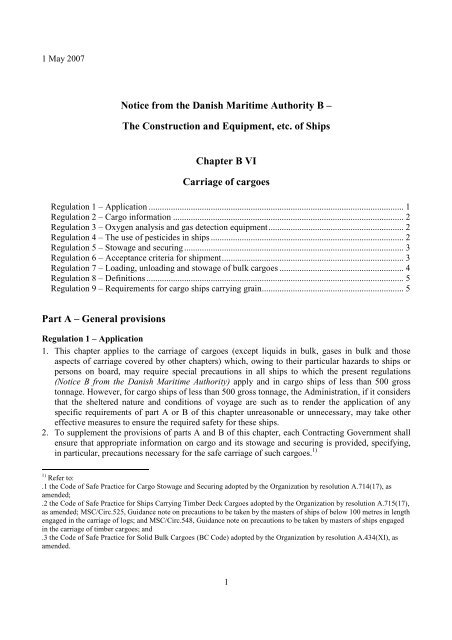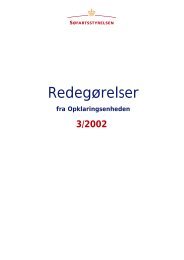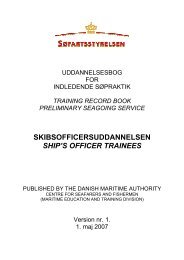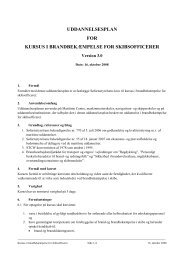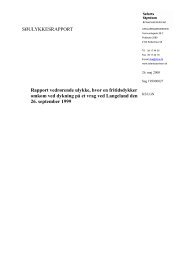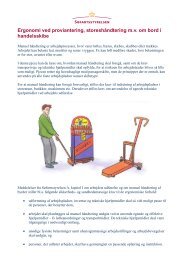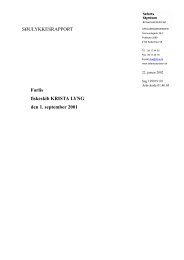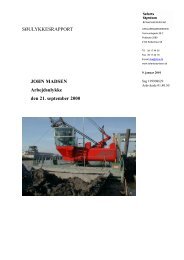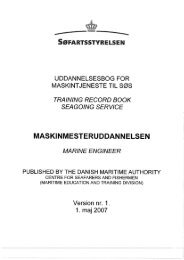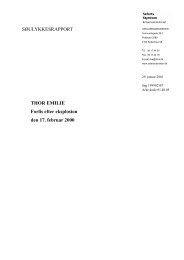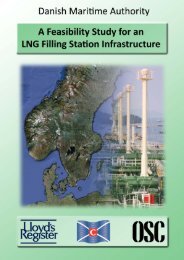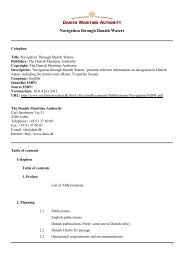Notice from the Danish Maritime Authority B
Notice from the Danish Maritime Authority B
Notice from the Danish Maritime Authority B
You also want an ePaper? Increase the reach of your titles
YUMPU automatically turns print PDFs into web optimized ePapers that Google loves.
1 May 2007<br />
<strong>Notice</strong> <strong>from</strong> <strong>the</strong> <strong>Danish</strong> <strong>Maritime</strong> <strong>Authority</strong> B –<br />
The Construction and Equipment, etc. of Ships<br />
Chapter B VI<br />
Carriage of cargoes<br />
Regulation 1 – Application ................................................................................................................... 1<br />
Regulation 2 – Cargo information ........................................................................................................ 2<br />
Regulation 3 – Oxygen analysis and gas detection equipment............................................................. 2<br />
Regulation 4 – The use of pesticides in ships ....................................................................................... 2<br />
Regulation 5 – Stowage and securing ................................................................................................... 3<br />
Regulation 6 – Acceptance criteria for shipment.................................................................................. 3<br />
Regulation 7 – Loading, unloading and stowage of bulk cargoes ........................................................ 4<br />
Regulation 8 – Definitions .................................................................................................................... 5<br />
Regulation 9 – Requirements for cargo ships carrying grain................................................................ 5<br />
Part A – General provisions<br />
Regulation 1 – Application<br />
1. This chapter applies to <strong>the</strong> carriage of cargoes (except liquids in bulk, gases in bulk and those<br />
aspects of carriage covered by o<strong>the</strong>r chapters) which, owing to <strong>the</strong>ir particular hazards to ships or<br />
persons on board, may require special precautions in all ships to which <strong>the</strong> present regulations<br />
(<strong>Notice</strong> B <strong>from</strong> <strong>the</strong> <strong>Danish</strong> <strong>Maritime</strong> <strong>Authority</strong>) apply and in cargo ships of less than 500 gross<br />
tonnage. However, for cargo ships of less than 500 gross tonnage, <strong>the</strong> Administration, if it considers<br />
that <strong>the</strong> sheltered nature and conditions of voyage are such as to render <strong>the</strong> application of any<br />
specific requirements of part A or B of this chapter unreasonable or unnecessary, may take o<strong>the</strong>r<br />
effective measures to ensure <strong>the</strong> required safety for <strong>the</strong>se ships.<br />
2. To supplement <strong>the</strong> provisions of parts A and B of this chapter, each Contracting Government shall<br />
ensure that appropriate information on cargo and its stowage and securing is provided, specifying,<br />
in particular, precautions necessary for <strong>the</strong> safe carriage of such cargoes. 1)<br />
1) Refer to:<br />
.1 <strong>the</strong> Code of Safe Practice for Cargo Stowage and Securing adopted by <strong>the</strong> Organization by resolution A.714(17), as<br />
amended;<br />
.2 <strong>the</strong> Code of Safe Practice for Ships Carrying Timber Deck Cargoes adopted by <strong>the</strong> Organization by resolution A.715(17),<br />
as amended; MSC/Circ.525, Guidance note on precautions to be taken by <strong>the</strong> masters of ships of below 100 metres in length<br />
engaged in <strong>the</strong> carriage of logs; and MSC/Circ.548, Guidance note on precautions to be taken by masters of ships engaged<br />
in <strong>the</strong> carriage of timber cargoes; and<br />
.3 <strong>the</strong> Code of Safe Practice for Solid Bulk Cargoes (BC Code) adopted by <strong>the</strong> Organization by resolution A.434(XI), as<br />
amended.<br />
1
1 May 2007<br />
Regulation 2 – Cargo information<br />
1. The shipper shall provide <strong>the</strong> master or his representative with appropriate information on <strong>the</strong> cargo<br />
in due time in advance of loading to enable <strong>the</strong> necessary precautions for proper stowage and safe<br />
carriage of <strong>the</strong> cargo to be put into effect. Such information 2) shall be confirmed in writing 3) and by<br />
appropriate shipping documents prior to loading <strong>the</strong> cargo.<br />
2. The cargo information shall include:<br />
2.1. in <strong>the</strong> case of general cargo, and of cargo carried in cargo units, a general description of <strong>the</strong><br />
cargo, <strong>the</strong> gross mass of <strong>the</strong> cargo or of <strong>the</strong> cargo units, and any relevant special properties of<br />
<strong>the</strong> cargo. For <strong>the</strong> purpose of this regulation <strong>the</strong> cargo information required in sub-chapter 1.9<br />
of <strong>the</strong> Code of Safe Practice for Cargo Stowage and Securing, adopted by <strong>the</strong> Organization by<br />
resolution A.714 (17), as amended, shall be provided. Any amendment to subchapter 1.9 shall<br />
be adopted, brought into force and take effect in accordance with <strong>the</strong> provisions of article VIII<br />
of <strong>the</strong> present Convention concerning <strong>the</strong> amendment procedures applicable to <strong>the</strong> annex<br />
o<strong>the</strong>r than chapter I;<br />
2.2. in <strong>the</strong> case of bulk cargo, information on <strong>the</strong> stowage factor of <strong>the</strong> cargo, <strong>the</strong> trimming<br />
procedures, likelihood of shifting including angle of repose, if applicable, and any o<strong>the</strong>r<br />
relevant special properties. In <strong>the</strong> case of a concentrate or o<strong>the</strong>r cargo which may liquefy,<br />
additional information in <strong>the</strong> form of a certificate on <strong>the</strong> moisture content of <strong>the</strong> cargo and its<br />
transportable moisture limit.<br />
2.3. in <strong>the</strong> case of a bulk cargo not classified in accordance with <strong>the</strong> provisions of <strong>the</strong> IMDG Code<br />
as defined in regulation VII/1.1, but which has chemical properties that may create a potential<br />
hazard, in addition to <strong>the</strong> information required by <strong>the</strong> preceding subparagraphs, information<br />
on its chemical properties.<br />
3. Prior to loading cargo units on board ships, <strong>the</strong> shipper shall ensure that <strong>the</strong> gross mass of such units<br />
is in accordance with <strong>the</strong> gross mass declared on <strong>the</strong> shipping documents.<br />
Regulation 3 – Oxygen analysis and gas detection equipment<br />
1. When transporting a bulk cargo which is liable to emit a toxic or flammable gas, or cause oxygen<br />
depletion in <strong>the</strong> cargo space, an appropriate instrument for measuring <strong>the</strong> concentration of gas or<br />
oxygen in <strong>the</strong> air shall be provided toge<strong>the</strong>r with detailed instructions for its use. Such an<br />
instrument shall be to <strong>the</strong> satisfaction of <strong>the</strong> Administration.<br />
2. The Administration shall take steps to ensure that crews of ships are trained in <strong>the</strong> use of such<br />
instruments.<br />
Regulation 4 – The use of pesticides in ships 4)<br />
Appropriate precautions shall be taken in <strong>the</strong> use of pesticides in ships, in particular for <strong>the</strong> purposes of<br />
fumigation.<br />
.4 <strong>the</strong> relevant provisions in Resolution A.863(20), <strong>the</strong> Code of Safe Practice for Solid Bulk Cargoes (BC-Code).<br />
2) Refer to MSC/Circ.663,Form for cargo information.<br />
3) Reference to documents in this regulation does not preclude <strong>the</strong> use of electronic data processing (EDP) and electronic<br />
data interchange (EDI) transmission techniques as an aid to paper documentation.<br />
4) Refer to <strong>the</strong> IMO Recommendation on <strong>the</strong> Safe Use of Pesticides in ships, as amended.<br />
http://10.1.10.213/solas/regulations/chapter_VI/r4.htm2008-05-08 19.45.51<br />
2
1 May 2007<br />
Regulation 5 – Stowage and securing<br />
1. Cargoes, cargo units 5) and cargo transport units 6) carried on or below deck shall be so loaded,<br />
stowed and secured as to prevent as far as is practicable, throughout <strong>the</strong> voyage, damage or hazard<br />
to <strong>the</strong> ship and <strong>the</strong> persons on board, and loss of cargo overboard.<br />
2. Cargo, cargo units and cargo transport units shall be so packed and secured within <strong>the</strong> unit as to<br />
prevent, throughout <strong>the</strong> voyage, damage or hazard to <strong>the</strong> ship and <strong>the</strong> persons on board.<br />
3. Appropriate precautions shall be taken during loading and transport of heavy cargoes or cargoes<br />
with abnormal physical dimensions to ensure that no structural damage to <strong>the</strong> ship occurs and to<br />
maintain adequate stability throughout <strong>the</strong> voyage.<br />
4. Appropriate precautions shall be taken during loading and transport of cargo units and cargo<br />
transport units on board ro-ro ships, particularly with regard to <strong>the</strong> lashing arrangements on board<br />
such ships and on <strong>the</strong> cargo units and cargo transport units and with regard to <strong>the</strong> strength of <strong>the</strong><br />
lashing points and lashings.<br />
5. Freight containers shall not be loaded to more than <strong>the</strong> maximum gross weight indicated on <strong>the</strong><br />
Safety Approval Plate under <strong>the</strong> International Convention for Safe Containers (CSC), as amended.<br />
6. All cargoes, o<strong>the</strong>r than solid and liquid bulk cargoes, cargo units and cargo transport units, shall be<br />
loaded, stowed and secured throughout <strong>the</strong> voyage in accordance with <strong>the</strong> Cargo Securing Manual<br />
approved by <strong>the</strong> Administration. In ships with ro-ro spaces, as defined in regulation II-2/3.41, all<br />
securing of such cargoes, cargo units and cargo transport units, in accordance with <strong>the</strong> Cargo<br />
Securing Manual, shall be completed before <strong>the</strong> ship leaves <strong>the</strong> berth. The Cargo Securing Manual<br />
shall be drawn up to a standard at least equivalent to relevant guidelines developed by <strong>the</strong><br />
Organization 7) .<br />
Part B – Special provisions for bulk cargoes o<strong>the</strong>r than grain<br />
Regulation 6 – Acceptance criteria for shipment<br />
1. Prior to loading a bulk cargo, <strong>the</strong> master shall be in possession of comprehensive information on <strong>the</strong><br />
ship's stability and on <strong>the</strong> distribution of cargo for <strong>the</strong> standard loading conditions. The method of<br />
providing such information shall be to <strong>the</strong> satisfaction of <strong>the</strong> Administration 8)<br />
2. Concentrates or o<strong>the</strong>r cargoes which may liquefy shall only be accepted for loading when <strong>the</strong> actual<br />
moisture content of <strong>the</strong> cargo is less than its transportable moisture limit. However, such<br />
concentrates and o<strong>the</strong>r cargoes may be accepted for loading even when <strong>the</strong>ir moisture content<br />
exceeds <strong>the</strong> above limit, provided that safety arrangements to <strong>the</strong> satisfaction of <strong>the</strong> Administration<br />
5) Refer to <strong>the</strong> Code of Safe Practice for Cargo Stowage and Securing, adopted by <strong>the</strong> Organization by resolution A.714(17)<br />
as amended.<br />
6) Refer to <strong>the</strong> International <strong>Maritime</strong> Dangerous Goods (IMDG) Code, adopted by <strong>the</strong> Organization by resolution<br />
MSC.122(75)<br />
7) Refer to <strong>the</strong> MSC/Circ.385 on <strong>the</strong> Cargo Securing Manual and <strong>the</strong> Guidelines on <strong>the</strong> preparation of <strong>the</strong> Cargo Securing<br />
Manual (MSC/Circ.745).<br />
8) .Refer to <strong>the</strong> Recommendation on intact stability for all ship types subject to <strong>the</strong> IMO instruments, adopted by <strong>the</strong><br />
Organization by resolution A.749(18) and amended by resolution MSC.75(69). Fur<strong>the</strong>rmore, reference is made to<br />
MSC/Circ. 456, model Loading and Stability Manual, MSC/Circ. 706, Guidance on intact stability of existing tankers<br />
during liquid transfer operations, and MSC/Circ.1228Revised Guidance to <strong>the</strong> master for avoiding dangerous situations in<br />
adverse wea<strong>the</strong>r and sea conditions.. In addition, reference is made to <strong>the</strong> latest Guidance on <strong>the</strong> approval of ship stability<br />
issued by <strong>the</strong> <strong>Danish</strong> <strong>Maritime</strong> <strong>Authority</strong>.<br />
3
1 May 2007<br />
are made to ensure adequate stability in case of cargo shifting and fur<strong>the</strong>r provided that <strong>the</strong> ship has<br />
adequate structural integrity.<br />
3. Prior to loading a bulk cargo which is not a cargo classified in accordance with <strong>the</strong> provisions of <strong>the</strong><br />
IMDG Code, as defined in regulation VII/1.1 but which has chemical properties that may create a<br />
potential hazard, special precautions for its safe carriage shall be taken.<br />
Regulation 7 – Loading, unloading and stowage of bulk cargoes 9)<br />
1. For <strong>the</strong> purpose of this regulation, “terminal representative” means a person appointed by <strong>the</strong><br />
terminal or o<strong>the</strong>r facility, where <strong>the</strong> ship is loading or unloading, who has responsibility for<br />
operations conducted by that terminal or facility with regard to <strong>the</strong> particular ship.<br />
2. To enable <strong>the</strong> master to prevent excessive stresses in <strong>the</strong> ship's structure, <strong>the</strong> ship shall be provided<br />
with a booklet, which shall be written in a language with which <strong>the</strong> ship's officers responsible for<br />
cargo operations are familiar. If this language is not English, <strong>the</strong> ship shall be provided with a<br />
booklet written also in <strong>the</strong> English language. The booklet shall, as a minimum, include:<br />
2.1. stability data, as required by regulation II-1/22 ;<br />
2.2. ballasting and deballasting rates and capacities;<br />
2.3. maximum allowable load per unit surface area of <strong>the</strong> tank top plating;<br />
2.4. maximum allowable load per hold;<br />
2.5. general loading and unloading instructions with regard to <strong>the</strong> strength of <strong>the</strong> ship's structure<br />
including any limitations on <strong>the</strong> most adverse operating conditions during loading, unloading,<br />
ballasting operations and <strong>the</strong> voyage;<br />
2.6. any special restrictions such as limitations on <strong>the</strong> most adverse operating conditions imposed<br />
by <strong>the</strong> Administration or organization recognized by it, if applicable; and<br />
2.7. where strength calculations are required, maximum permissible forces and moments on <strong>the</strong><br />
ship's hull during loading, unloading and <strong>the</strong> voyage.<br />
3. Before a solid bulk cargo is loaded or unloaded, <strong>the</strong> master and <strong>the</strong> terminal representative shall<br />
agree on a plan 10) which shall ensure that <strong>the</strong> permissible forces and moments on <strong>the</strong> ship are not<br />
exceeded during loading or unloading, and shall include <strong>the</strong> sequence, quantity and rate of loading<br />
or unloading, taking into consideration <strong>the</strong> speed of loading or unloading, <strong>the</strong> number of pours and<br />
<strong>the</strong> deballasting or ballasting capability of <strong>the</strong> ship. The plan and any subsequent amendments<br />
<strong>the</strong>reto shall be lodged with <strong>the</strong> appropriate authority of <strong>the</strong> port State.<br />
4. Bulk cargoes shall be loaded and trimmed reasonably level, as necessary, to <strong>the</strong> boundaries of <strong>the</strong><br />
cargo space so as to minimize <strong>the</strong> risk of shifting and to ensure that adequate stability will be<br />
maintained throughout <strong>the</strong> voyage.<br />
5. When bulk cargoes are carried in 'tween-decks, <strong>the</strong> hatchways of such 'tween-decks shall be closed<br />
in those cases where <strong>the</strong> loading information indicates an unacceptable level of stress of <strong>the</strong> bottom<br />
structure if <strong>the</strong> hatchways are left open. The cargo shall be trimmed reasonably level and shall<br />
ei<strong>the</strong>r extend <strong>from</strong> side to side or be secured by additional longitudinal divisions of sufficient<br />
strength. The safe load-carrying capacity of <strong>the</strong> 'tween-decks shall be observed to ensure that <strong>the</strong><br />
deck-structure is not overloaded.<br />
9) Refer to <strong>the</strong> Code of Practice for <strong>the</strong> Safe Loading and Unloading of Bulk Carriers (BLU Code) adopted by <strong>the</strong><br />
Organization by resolution A.862(20).<br />
10) See note 9).<br />
4
1 May 2007<br />
6. The master and terminal representative shall ensure that loading and unloading operations are<br />
conducted in accordance with <strong>the</strong> agreed plan.<br />
7. If during loading or unloading any of <strong>the</strong> limits of <strong>the</strong> ship referred to in paragraph 2 are exceeded<br />
or are likely to become so if <strong>the</strong> loading or unloading continues, <strong>the</strong> master has <strong>the</strong> right to suspend<br />
operation and <strong>the</strong> obligation to notify accordingly <strong>the</strong> appropriate authority of <strong>the</strong> port State with<br />
which <strong>the</strong> plan has been lodged. The master and <strong>the</strong> terminal representative shall ensure that<br />
corrective action is taken. When unloading cargo, <strong>the</strong> master and terminal representative shall<br />
ensure that <strong>the</strong> unloading method does not damage <strong>the</strong> ship's structure.<br />
8. The master shall ensure that ship's personnel continuously monitor cargo operations. Where<br />
possible, <strong>the</strong> ship's draught shall be checked regularly during loading or unloading to confirm <strong>the</strong><br />
tonnage figures supplied. Each draught and tonnage observation shall be recorded in a cargo logbook.<br />
If significant deviations <strong>from</strong> <strong>the</strong> agreed plan are detected, cargo or ballast operations or both<br />
shall be adjusted to ensure that <strong>the</strong> deviations are corrected.<br />
Part C – Carriage of grain<br />
Regulation 8 – Definitions<br />
For <strong>the</strong> purposes of this part, unless expressly provided o<strong>the</strong>rwise:<br />
1. “International Grain Code” means <strong>the</strong> International Code for <strong>the</strong> Safe Carriage of Grain in Bulk<br />
adopted by <strong>the</strong> <strong>Maritime</strong> Safety Committee of <strong>the</strong> Organization by resolution MSC.23(59) as may<br />
be amended by <strong>the</strong> Organization, provided that such amendments are adopted, brought into force<br />
and take effect in accordance with <strong>the</strong> provisions of article VIII of <strong>the</strong> present Convention<br />
concerning <strong>the</strong> amendment procedures applicable to <strong>the</strong> annex o<strong>the</strong>r than chapter I.<br />
2. The term “grain” includes wheat, maize (corn), oats, rye, barley, rice, pulses, seeds and processed<br />
forms <strong>the</strong>reof whose behaviour is similar to that of grain in its natural state.<br />
Regulation 9 – Requirements for cargo ships carrying grain<br />
1. In addition to any o<strong>the</strong>r applicable requirements of <strong>the</strong> present regulations, a cargo ship carrying<br />
grain shall comply with <strong>the</strong> requirements of <strong>the</strong> International Grain Code, and hold a document of<br />
authorization as required by that Code. For <strong>the</strong> purpose of this regulation, <strong>the</strong> requirements of <strong>the</strong><br />
Code shall be treated as mandatory.<br />
2. A ship without such a document shall not load grain until <strong>the</strong> master satisfies <strong>the</strong> Administration, or<br />
<strong>the</strong> Contracting Government of <strong>the</strong> port of loading on behalf of <strong>the</strong> Administration, that <strong>the</strong> ship<br />
will comply with <strong>the</strong> requirements of <strong>the</strong> International Grain Code in its proposed loaded condition.<br />
5


